Small overlap front
The small overlap front evaluation consists of a driver-side and a passenger-side component. If the results of the two evaluations differ, then the combined small overlap rating is equal to the lower rating.
Driver-side
- Rating applies to 2019-24 models built after July 2018
Tested vehicle: 2019 Ram 1500 Big Horn Crew Cab 2wd
The Ram 1500 Crew Cab was redesigned for the 2019 model year. The earlier design remained in production for the 2019-20 model years and was called the Ram 1500 Classic Crew Cab. The ratings on this page do not apply to the Classic.
For the redesigned pickup beginning with 2019 models built after July 2018, the cab mounts to the vehicle frame at the C-pillars were strengthened to improve occupant protection in small overlap frontal crashes. (Information about when a specific vehicle was manufactured is on the certification label typically affixed to the car on the driver door or adjacent B-pillar.)
Two tests of the Ram 1500 Crew Cab were conducted by the Institute; vehicle specifications for the two trucks were identical. In the first test, Fiat Chrysler identified possible prior dummy ankle damage that may have caused elevated injury measures on the left lower leg. In the second test with a new ankle assembly installed, there were also indications of elevated left lower leg injury. Therefore, the ratings are based on combined results from both tests.
| Evaluation criteria | Rating |
|---|---|
| Overall driver-side evaluation | |
| Structure and safety cage | |
| Driver injury measures | |
| Head/neck | |
| Chest | |
| Hip/thigh | |
| Lower leg/foot | |
| Driver restraints and dummy kinematics | |
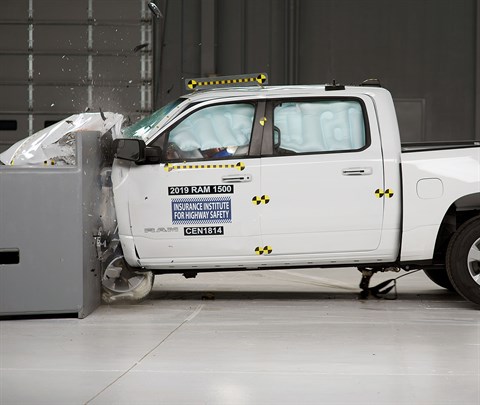
Action shot taken during the second of two driver-side small overlap frontal crash tests.
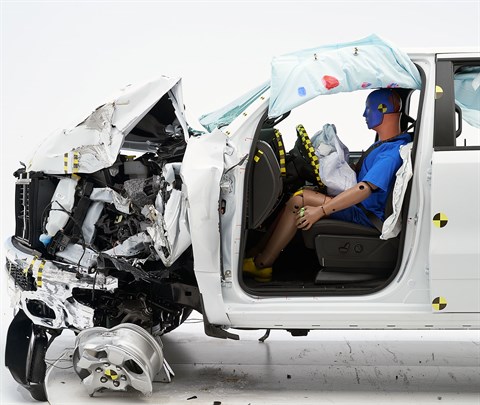
The dummy's position in relation to the door frame, steering wheel, and instrument panel after the crash test indicates that the driver's survival space was maintained well (second test shown).
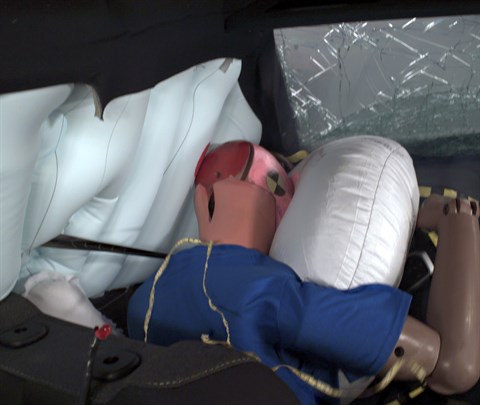
The frontal and side curtain airbags worked well together to keep the head from coming close to any stiff structure or outside objects that could cause injury (second test shown).

Forces on the left lower leg were high enough to indicate a likely risk of injury in the first test (shown) and a moderate risk in the second test.
Passenger-side
- Rating applies to 2019-24 models built after July 2018
Tested vehicle: 2019 Ram1500 Tradesman Crew Cab 2wd
The Ram 1500 Crew Cab was redesigned for the 2019 model year. The earlier design remained in production for the 2019-20 model years and was called the Ram 1500 Classic Crew Cab. The ratings on this page do not apply to the Classic.
For the redesigned pickup beginning with 2019 models built after July 2018, the cab mounts to the vehicle frame at the C-pillars were strengthened to improve occupant protection in small overlap frontal crashes. (Information about when a specific vehicle was manufactured is on the certification label typically affixed to the car on the driver door or adjacent B-pillar.)
| Evaluation criteria | Rating |
|---|---|
| Overall passenger-side evaluation | |
| Structure and safety cage | |
| Passenger injury measures | |
| Head/neck | |
| Chest | |
| Hip/thigh | |
| Lower leg/foot | |
| Passenger restraints and dummy kinematics | |
| Driver injury measures | |
| Head/neck | |
| Chest | |
| Hip/thigh | |
| Lower leg/foot | |
| Driver restraints and dummy kinematics | |
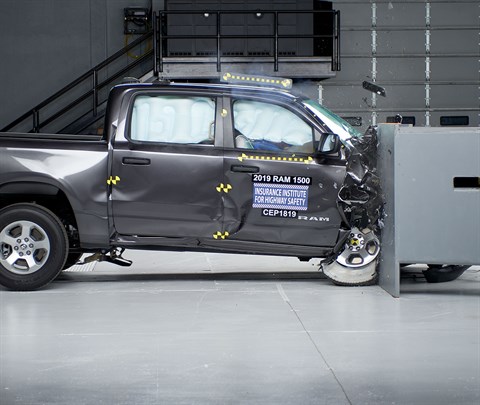
Action shot taken during the passenger-side small overlap frontal crash test.
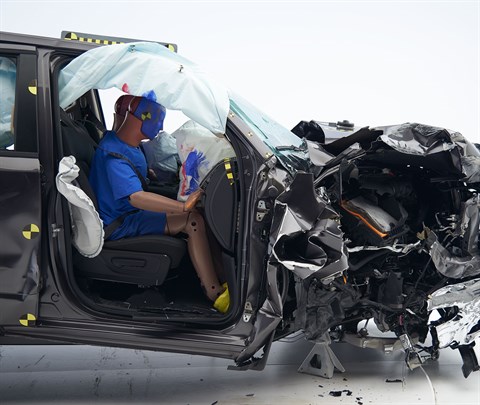
The dummy's position in relation to the door frame and dashboard after the crash test indicates that the passenger’s survival space was maintained reasonably well.
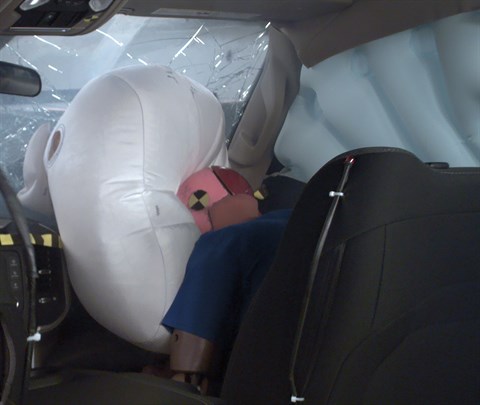
The frontal and side curtain airbags worked well together to keep the head from coming close to any stiff structure or outside objects that could cause injury.
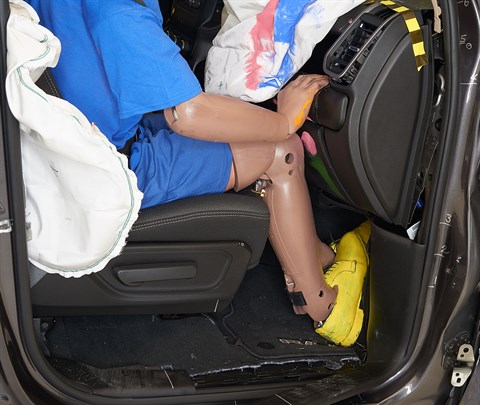
Despite intrusion of the toepan and dashboard, risk of injuries to the dummy's legs and feet was low.
Moderate overlap front: original test
Rating applies to 2019-24 models
Tested vehicle: 2019 Ram 1500 Big Horn Crew Cab 2wd
The Ram 1500 Crew Cab was redesigned for the 2019 model year. The earlier design remained in production for the 2019-20 model years and was called the Ram 1500 Classic Crew Cab. The ratings on this page do not apply to the Classic.
Moderate overlap frontal ratings are assigned by the Institute based on a test conducted by Fiat Chrysler.
| Evaluation criteria | Rating |
|---|---|
| Overall evaluation | |
| Structure and safety cage | |
| Driver injury measures | |
| Head/neck | |
| Chest | |
| Leg/foot, left | |
| Leg/foot, right | |
| Driver restraints and dummy kinematics | |
Moderate overlap front: updated test
Rating applies to 2023-24 models
Tested vehicle: 2023 Ram 1500 Big Horn Crew Cab 4wd
The Ram 1500 Crew Cab was redesigned for the 2019 model year.
| Evaluation criteria | Rating |
|---|---|
| Overall evaluation | |
| Structure and safety cage | |
| Driver injury measures | |
| Head/neck | |
| Chest | |
| Thigh/hip | |
| Leg/foot | |
| Driver restraints and dummy kinematics | |
| Rear passenger injury measures | |
| Head/neck | |
| Chest | |
| Thigh | |
|
Rear passenger restraints and dummy kinematics
| |
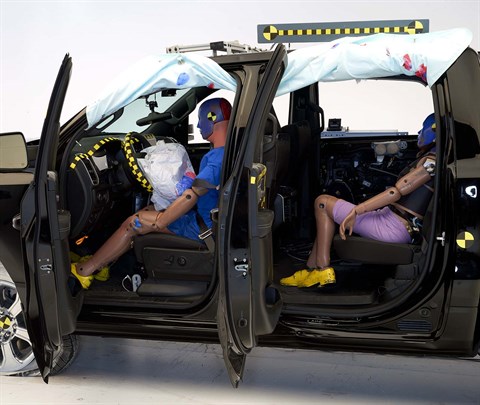
View of the vehicle after the crash showing the airbags and damage to the occupant compartment.
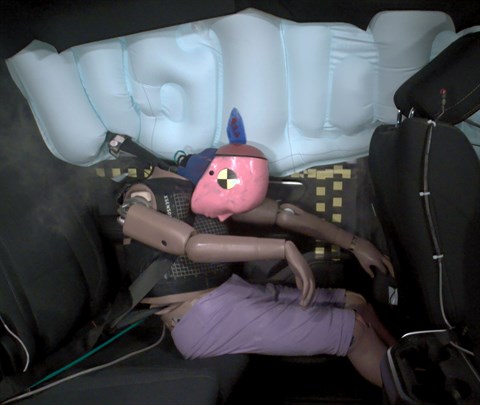
The rear passenger dummy's head remained a safe distance from the front seatback.
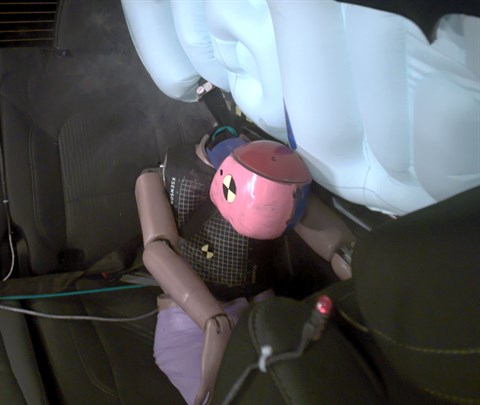
Rear passenger dummy injury values indicate a likely risk of injury to the head or neck and chest. During the crash, the shoulder belt remained in an ideal position on the dummy’s chest.
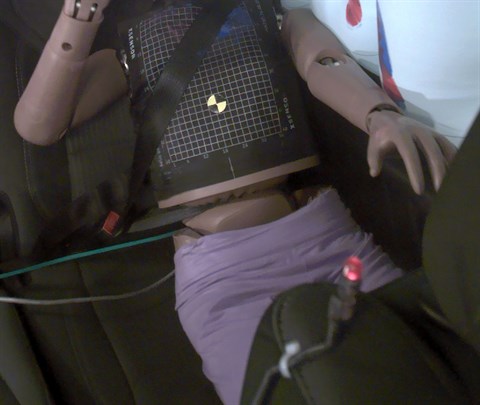
The rear passenger dummy's lap belt moved from the ideal position on the pelvis onto the abdomen, increasing the risk of abdominal injuries.
Side: updated test
Rating applies to 2019-25 models
Tested vehicle: 2023 Ram 1500 Big Horn Crew Cab 4wd
The Ram 1500 Crew Cab was redesigned for the 2019 model year. The earlier design remained in production for the 2019-20 model years and was called the Ram 1500 Classic Crew Cab. The ratings on this page do not apply to the Classic.
| Evaluation criteria | Rating |
|---|---|
| Overall evaluation | |
| Structure and safety cage | |
| Driver injury measures | |
| Head/neck | |
| Torso | |
| Pelvis | |
| Driver head protection | |
| Rear passenger injury measures | |
| Head/neck | |
| Torso | |
| Pelvis | |
| Rear passenger head protection | |
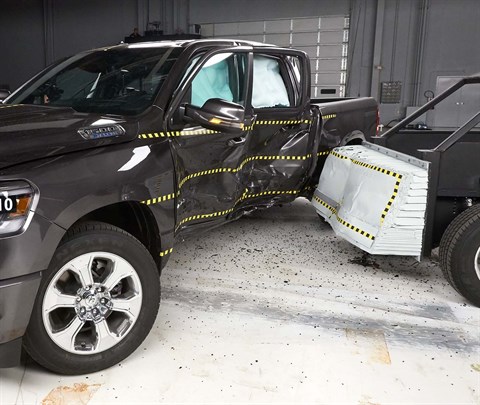
View of the vehicle just after the crash test.
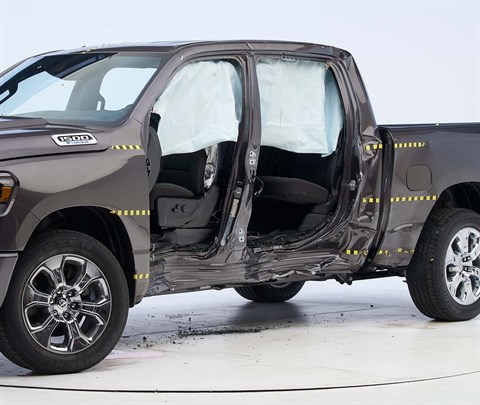
View of the vehicle after the crash with doors removed, showing the side airbags and damage to the occupant compartment.
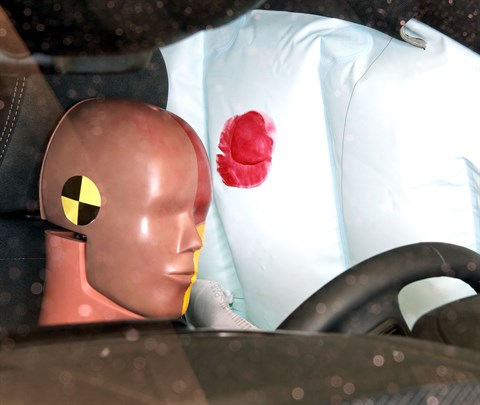
Smeared greasepaint shows where the driver dummy's head was protected from being hit by hard structures by the side airbags.
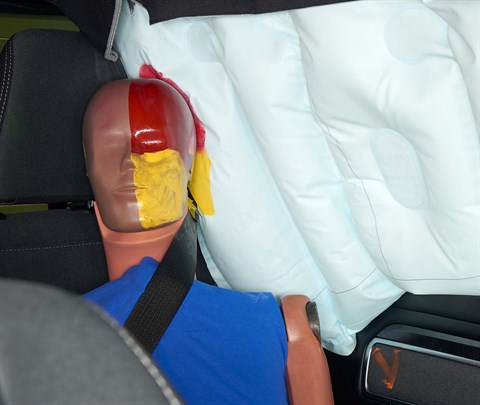
Smeared greasepaint shows where the rear passenger dummy’s head was protected by the side airbag.
Headlights
Ratings are given for 5 different headlight variations available on this vehicle.
Trim level(s)
- Longhorn trim
- Limited trim
- TRX trim
| Evaluation criteria | Rating |
|---|---|
| Low-beam headlight type | LED projector |
| High-beam headlight type | LED projector |
| Curve-adaptive? | Yes |
| High-beam assist? | Yes |
|
Overall rating | |
| Distance at which headlights provide at least 5 lux illumination: | |
Low beams
On the straightaway, visibility was fair on both sides of the road. On curves, visibility was good on both right curves, fair on the sharp left curve and inadequate on the gradual left curve.
The low beams never exceeded glare limits.
High beams
On the straightaway, visibility was good on the right side of the road and fair on the left side. On curves, visibility was good on the gradual left and both right curves and fair on the sharp left curve.
High-beam assist compensates for some limitations of this vehicle's low beams on the straightaway and on both left curves.
Trim level(s)
- Laramie trim equipped with Advanced Safety Group package
| Evaluation criteria | Rating |
|---|---|
| Low-beam headlight type | Halogen reflector |
| High-beam headlight type | Halogen reflector |
| Curve-adaptive? | No |
| High-beam assist? | Yes |
|
Overall rating | |
| Distance at which headlights provide at least 5 lux illumination: | |
Low beams
On the straightaway, visibility was good on the left side of the road and fair on the right side. On curves, visibility was inadequate in all 4 tests.
The low beams never exceeded glare limits.
High beams
On the straightaway, visibility was good on both sides of the road. On curves, visibility was inadequate in all 4 tests.
High-beam assist compensates for some limitations of this vehicle's low beams on the straightaway, on both left curves and on both right curves.
Trim level(s)
- Tradesman trim
- Big Horn trim
- Lone Star trim
- Laramie trim
| Evaluation criteria | Rating |
|---|---|
| Low-beam headlight type | Halogen reflector |
| High-beam headlight type | Halogen reflector |
| Curve-adaptive? | No |
| High-beam assist? | No |
|
Overall rating | |
| Distance at which headlights provide at least 5 lux illumination: | |
Low beams
On the straightaway, visibility was good on the left side of the road and fair on the right side. On curves, visibility was inadequate in all 4 tests.
The low beams never exceeded glare limits.
High beams
On the straightaway, visibility was good on both sides of the road. On curves, visibility was inadequate in all 4 tests.
Trim level(s)
- Laramie trim equipped with Laramie 1 Equipment Group package
- Laramie trim equipped with Laramie 2 Equipment Group package
- Rebel trim equipped with Advanced Safety Group package
- Laramie trim equipped with Laramie B Equipment Group package
| Evaluation criteria | Rating |
|---|---|
| Low-beam headlight type | LED reflector |
| High-beam headlight type | LED reflector |
| Curve-adaptive? | No |
| High-beam assist? | Yes |
|
Overall rating | |
| Distance at which headlights provide at least 5 lux illumination: | |
Low beams
On the straightaway, visibility was fair on the left side of the road and inadequate on the right side. On curves, visibility was good on the sharp right curve, fair on the gradual right curve and inadequate on both left curves.
The low beams never exceeded glare limits.
High beams
On the straightaway, visibility was good on the right side of the road and fair on the left side. On curves, visibility was fair on both right curves and inadequate on both left curves.
High-beam assist compensates for some limitations of this vehicle's low beams on the straightaway and all 4 curves.
Trim level(s)
- Big Horn trim equipped with Premium Lighting Group package
- Rebel trim
- Lonestar trim equipped with Built-to-Serve Edition package
- Lone Star trim equipped with Premium Lighting Group package
- Big Horn trim equipped with Built-to-Serve Edition package
| Evaluation criteria | Rating |
|---|---|
| Low-beam headlight type | LED reflector |
| High-beam headlight type | LED reflector |
| Curve-adaptive? | No |
| High-beam assist? | No |
|
Overall rating | |
| Distance at which headlights provide at least 5 lux illumination: | |
Low beams
On the straightaway, visibility was fair on the left side of the road and inadequate on the right side. On curves, visibility was good on the sharp right curve, fair on the gradual right curve and inadequate on both left curves.
The low beams never exceeded glare limits.
High beams
On the straightaway, visibility was good on the right side of the road and fair on the left side. On curves, visibility was fair on both right curves and inadequate on both left curves.
Front crash prevention: pedestrian
Ratings are given for 2 different systems available on this vehicle.
Seat belt reminders
Rating applies to 2022-25 models
| Evaluation criteria | Rating |
|---|---|
| Overall evaluation | |
| Front row | |
| Unbelted occupant alert (audible & visual) | |
| Initiation time | |
| Duration | Long enough (90+ seconds) |
| Volume | |
| Audio frequency | |
| Second row | |
| Startup status alert (visual) | None |
Child seat anchors
Rating applies to 2019-25 models
| Evaluation criteria | Rating |
|---|---|
| Overall evaluation | |
| Vehicle trim | Limited Crew Cab |
| Seat type | leather |
This vehicle has 3 rear seating positions with complete child seat attachment (LATCH) hardware.
| Evaluation criteria | Rating |
|---|---|
| Overall evaluation | |
| Vehicle trim | Limited Crew Cab |
| Seat type | leather |
| Rating icon | Rating |
|---|---|
| G | Good |
| A | Acceptable |
| M | Marginal |
| P | Poor |
| Seating positions that rely on borrowed lower anchors or have only a tether anchor available are not rated. | |
thether anchor symbol | Tether anchor |
lower anchor symbol | Lower anchors |
| Lower anchor(s) can be borrowed from adjacent positions(s) | |
| No hardware available |
Details by seating position
| Position | Rating |
|---|---|
| 1 | |
| Tether anchor | |
| hard-to-find location | |
| other hardware could be confused for anchor | |
| Lower anchors | |
| not too deep in seat | |
| not too much force needed to attach | |
| easy to maneuver around anchors | |
| 2 | |
| Tether anchor | |
| hard-to-find location | |
| other hardware could be confused for anchor | |
| Lower anchors | |
| too deep in seat | |
| not too much force needed to attach | |
| easy to maneuver around anchors | |
| 3 | |
| Tether anchor | |
| hard-to-find location | |
| other hardware could be confused for anchor | |
| Lower anchors | |
| not too deep in seat | |
| not too much force needed to attach | |
| easy to maneuver around anchors |
